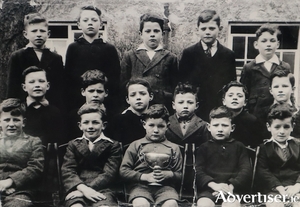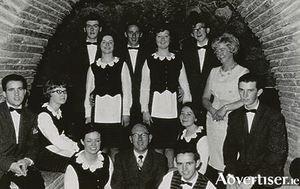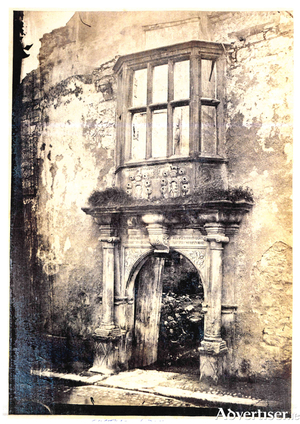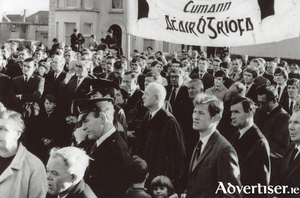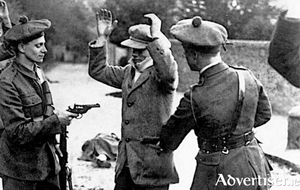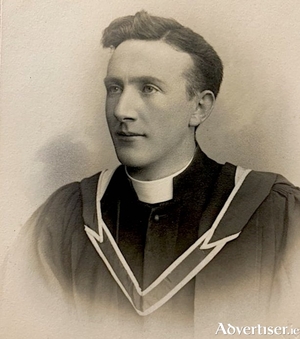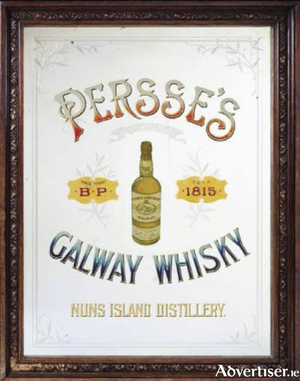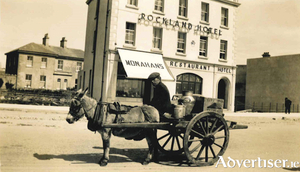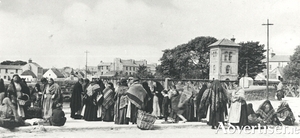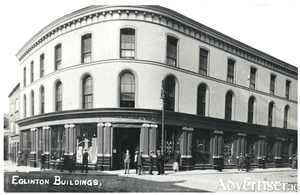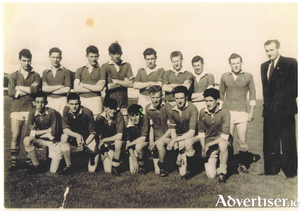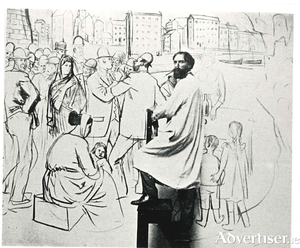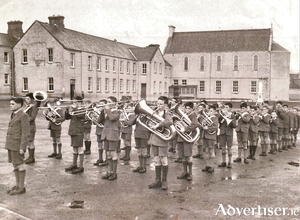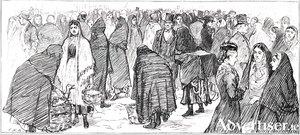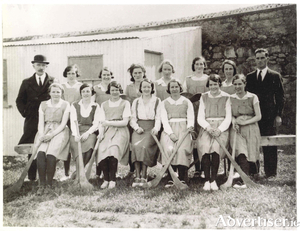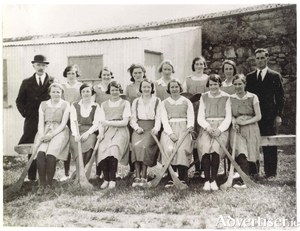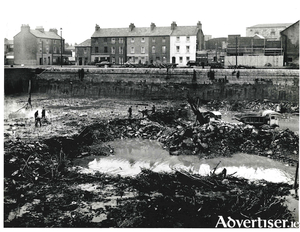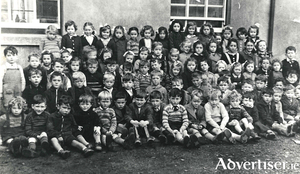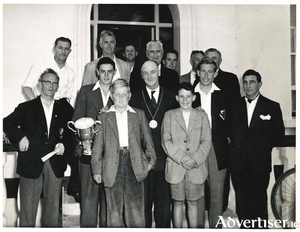One hundred and ninety five years of the Patrician Brothers in Galway
Wed, Dec 01, 2021
In 1790, the Rev Augustine Kirwan, Catholic warden of Galway, established the Galway Charity School near the Shambles Barracks for the education of poor boys. For a variety of reasons, the school failed and eventually, the Brothers of St Patrick, also known as the Patrician Brothers, an order founded in 1808, were invited to take charge.
Read more ...The Railway Hotel
Thu, Nov 25, 2021
This ancient site on the southern end of what we now know as Eyre Square was occupied by a Knights Templars convent in the 13th century. By the 17th century Robert Martin had a large house on the site, but this was taken from him by the Cromwellians and given to Edward Eyre. The Eyre family held on to the property and on May 12, 1712, Edward Eyre, son of the above, presented the land in front of his house to the corporation as a place of recreation for the people of Galway. In 1827, a man named Atkinson built houses at this end of the Square and by 1845, the site was occupied by a block of tenements owned by Fr Peter Daly.
Read more ...The Browne Doorway
Thu, Nov 18, 2021
According to a Browne family tradition, the first Browne to settle in Ireland was Phillipus de Browne who in 1172 was appointed Governor of Wexford. He had three sons, one of whom, Walter, settled in County Galway, where his posterity still remains. By around the year 1300, the Brownes seemed to have settled in the Athenry area. They were one of the 14 families from the Irish lower classes who rose to become Galway’s prime merchant families, and who famously were known as The Tribes of Galway.
Read more ...The unveiling of a plaque to Fr Griffin
Thu, Nov 11, 2021
On November 14, 1920, a young curate, Father Michael Griffin, was lured from his house at No 2 Montpellier Terrace by the Black and Tans. Whatever ruse they used to get him out of the house, it was not to go on a sick call, as he did not take the holy oils or the Eucharist with him, but went peacefully. He went missing and volunteers and search parties were organised and combed the city and surrounding countryside looking for him. A week later his body was found buried in a bog at Cloch Sgoilte in Barna. There was an international outcry. He had worked in the parish of Rahoon since June 1918 and was hugely popular. He spoke in Irish to young and old, organised feiseanna, currach races, and donkey races on Silver Strand. He was very republican and was suspected by the Tans of having heard the last confession of the informer Patrick Joyce, which was probably the reason why they abducted him and tried to extract the identity of Joyce's killers from him.
Read more ...Renewed calls for a memorial bench for IRA man killed by British army on grounds of NUIG
Thu, Nov 04, 2021
Renewed calls have been made for a memorial bench for War of Independence IRA leader, Michael Moran, to be erected on the grounds of NUI Galway.
Read more ...Fr Michael Griffin Mass and commemoration
Thu, Nov 04, 2021
The Annual Memorial Mass and Commemoration in memory of Fr Michael Griffin will take place on Sunday November 21.
Read more ...Persse’s Galway Whiskey
Thu, Nov 04, 2021
The name Persse is synonymous with Galway, the first members of the family having arrived in this country with the Cromwellians and many of them making significant contributions to life here since, the best known being Isabella Augusta Persse who later became Lady Gregory.
Read more ...The Rockland Hotel
Thu, Oct 28, 2021
In 1923 Forster Park, the residence of Gerald Cloherty, clerk of the crown and peace for County Galway, sold his house to surgeon Michael O’Malley. In July 1935 the Connacht Tribune reported that the purchase of plots in front of the house recently occupied by Dr O’Malley, and the question of allowing the purchasers to proceed with the building immediately, or to force them to defer until the road along the Promenade had been widened, was the subject of a long discussion at the Urban District Council meeting.
Read more ...The Fishmarket
Wed, Oct 20, 2021
The village of the Claddagh was a unique collection of thatched houses arranged in a very random fashion, occupied by a few thousand souls. They had their own customs, spoke mainly in Irish, intermarried each other, had their own code of laws, and elected their own king. He was quite powerful in many respects and usually solved local disputes. Claddagh people rarely went outside the village to courts of justice. Virtually the entire male population was involved in fishing, but when they landed their catch, it was the women who took over. They were the members of the family who went out and sold the product.
Read more ...Moon’s
Wed, Oct 13, 2021
This building was designed by a Mr Farquarson around the year 1812. It has a three storey façade. The bays on the ground floor are articulated by paired fluted ionic pilasters while on the first floor, there are round-headed windows with moulded architraves which are flush with the wall surface and on the second floor segmented–headed windows similarly treated. The exterior has been preserved unchanged since it was built and is one of the most attractive corners in Galway, complemented by the rounded corner of what used to be McNamara’s and the elegant corner of what used to be Dillon’s.
Read more ...In memory of Pa Boyle
Wed, Oct 06, 2021
In 1940, Shantalla was just green fields with an occasional farmhouse. A decade later, it was a sprawling housing estate with a large young population. They were slowly developing a sense of community, but sadly, they had no facilities such as parks or pitches to play games on.
Read more ...Augustus John’s cartoon of Galway
Wed, Sep 29, 2021
Augustus John was one of the great painters of the last century. He knew and painted many of the most famous people of his time, including prominent figures of the Irish Literary Revival such as Yeats, Seán O’Casey, and George Bernard Shaw.
Read more ...The Industrial School Band
Wed, Sep 22, 2021
In 1852, Fr Peter Daly purchased the estate of Kilcorkey from the Encumbered Estates Court. The owner of an adjoining site subsequently disputed his title to a particular plot and brought proceedings against him. Peter Daly, however, proceeded to construct on the plot in question a building he described as "A Benevolent Home for aged respectable females whose circumstances would render them unable to afford themselves a comfortable home". An attempt was made to settle the case out of court but it failed and, in court, judgment was given for the plaintiff Miss Grattan Esmonde. She was given possession of the house in August, 1863.
Read more ...Story of Galway-Clifden Railway to be launched this weekend
Thu, Sep 16, 2021
The first ever in-depth account of the gloriously scenic Galway-Clifden Railway which ran through the heart of Connemara from 1895 to 1935 will be launched this weekend in Maam Cross Railway Station.
This volume deals with all aspects of this major infrastructural and engineering achievement of its time – emigration, conflict, tourism, and its lasting affect on this most remote part of the Atlantic seaboard. Remarkably almost 90 years after closure the course the line is still mostly discernable..
Read more ...A Galway tradition
Wed, Sep 15, 2021
The origins of the centuries-old Saturday market are lost in the mists of time. It was always held in front of St Nicholas’ Collegiate Church, which was the only open space in the old walled town. Two hundred years ago, James Hardiman, in his history, was writing that, “The town is well supplied with vegetables … the green gardeners cultivate a considerable quantity of ground and keep a considerable supply of remarkable fine-flavoured fruit and vegetables.” At the same time, Hely Dutton, in his survey, was writing, “The vegetable market kept near the Main Guard is generally well supplied, and at reasonable rates; all kinds come to the market washed, by which any imperfection is easily detected. The cabbage raised near the sea side on seaweed is particularly delicious; those who have been used to those cultivated on ground highly manured, cannot form any idea of the difference. There are also, in season, peaches, strawberries, gooseberries, apples, pears etc.”
Read more ...Gaillimh abú
Fri, Sep 10, 2021
It was inevitable in a county which was a stronghold of hurling that women would eventually want to play the game like their male counterparts. The game of camogie has been played in Galway since the early 1900s. Experimental rules for the female game were drawn up in 1903 and the first public match took place that year, and so the game of camogie was officially launched.
Read more ...Gaillimh abú
Wed, Sep 08, 2021
It was inevitable in a county which was a stronghold of hurling that women would eventually want to play the game like their male counterparts. The game of camogie has been played in Galway since the early 1900s. Experimental rules for the female game were drawn up in 1903 and the first public match took place that year, and so the game of camogie was officially launched.
Read more ...Dredging the Docks, 1963
Wed, Sep 01, 2021
Since Galway Docks were first constructed, they have undergone many changes. In the decade before the last world war, when transalantic liners were regular callers at the port, and when a fairly thriving coastal trade was being carried out, plans were prepared for the port so that Galway might cater more efficiently for sea traffic. There was a major scheme to build the Dún Aengus dock, the new pier, and to deepen the channel from 1937 to 1939. This meant the removal of thousands of tons of mud, soft materials, and granite. Most of this material was dumped near Hare Island. The work took longer than it should, mostly because of industrial disputes, but it was finally completed in 1939. Two units of the contractor’s equipment, a rock breaker and a floating crane, lay in the Commercial Dock throughout the war years.
Read more ...Back to school time
Wed, Aug 25, 2021
This is the time of the year when our thoughts turn to schoolbooks, copy books, pens and pencils, bus schedules, etc, as we prepare our children and grandchildren for the new school year. Inevitably it brings our thoughts back to our own school years, the friendships we formed, the teachers we liked or disliked. In those first days in class you felt you had been abandoned by your mother as she left you in with a crowd of complete strangers presided over by an adult that you had never seen before. In the case of anyone who went to Scoil Fhursa that adult was known as Bean Uí Duignan. She was a saint who quickly became a surrogate mother to every child that entered her classroom, walked them up and down the clós during sosanna, and prepared them for whatever was ahead.
Read more ...Galway Swimming Club, a brief history
Wed, Aug 18, 2021
Ninety years ago, on August 2, 1931, the world famous long-distance swimmer, Miss Mercedes Gleitz, attempted to swim from the Aran Islands to Salthill. She did in fact manage to swim from Inis Meán to Spiddal in 18 hours 43 minutes, a distance of 18 miles as the crow flies, but it was estimated that with currents, etc, she covered a distance of nearly 30 miles. Two days later she gave a swimming demonstration in Salthill and presented a cup to the Chamber of Commerce to be presented to the school in the county which presented the greatest number of swimmers in relation to its student numbers. She stimulated a lot of interest in the sport, which had received a terrific boost just a few months before with the formation of two clubs, Blackrock Swimming Club and Galway Swimming Club. This guaranteed competition between the clubs and quickly helped raise standards.
Read more ...